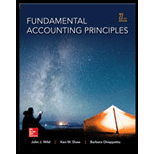
Fundamental Accounting Principles -Hardcover
22nd Edition
ISBN: 9780077862275
Author: John J Wild, Ken Shaw Accounting Professor, Barbara Chiappetta Fundamental Accounting Principles
Publisher: McGraw-Hill Education
expand_more
expand_more
format_list_bulleted
Question
Chapter 16, Problem 5E
To determine
Concept Introduction:
Cash: It includes Cash in Hand & Deposits with Bank.
Cash Equivalents: It includes those investments which are short term investment and highly liquid i.e. maturity period is of three months or less.
Operating Activities: Operating Activities are the principal revenue generating activities of enterprise. In other words activities that are not financing and investing activities.
To Prepare:
The Cash Flow from Operating Activities as on 31st Dec 2015.
Expert Solution & Answer
Want to see the full answer?
Check out a sample textbook solution
Students have asked these similar questions
Provide accounting answer
General accounting question
I need help with this general accounting question using the proper accounting approach.
Chapter 16 Solutions
Fundamental Accounting Principles -Hardcover
Ch. 16 - Prob. 1DQCh. 16 - Prob. 2DQCh. 16 - Prob. 3DQCh. 16 - Prob. 4DQCh. 16 - Prob. 5DQCh. 16 - Prob. 6DQCh. 16 - Prob. 7DQCh. 16 - Prob. 8DQCh. 16 - Prob. 9DQCh. 16 - Prob. 10DQ
Ch. 16 - Prob. 11DQCh. 16 - Prob. 12DQCh. 16 - Prob. 13DQCh. 16 - Prob. 14DQCh. 16 - Prob. 15DQCh. 16 - Prob. 1QSCh. 16 - Prob. 2QSCh. 16 - Prob. 3QSCh. 16 - Prob. 4QSCh. 16 - Prob. 5QSCh. 16 - Prob. 6QSCh. 16 - Prob. 7QSCh. 16 - Prob. 8QSCh. 16 - Prob. 9QSCh. 16 - Prob. 10QSCh. 16 - Prob. 11QSCh. 16 - Prob. 12QSCh. 16 - Prob. 13QSCh. 16 - Prob. 14QSCh. 16 - Prob. 15QSCh. 16 - Prob. 16QSCh. 16 - Prob. 17QSCh. 16 - Prob. 18QSCh. 16 - Prob. 19QSCh. 16 - Prob. 20QSCh. 16 - Prob. 1ECh. 16 - Prob. 2ECh. 16 - Prob. 3ECh. 16 - Prob. 4ECh. 16 - Prob. 5ECh. 16 - Prob. 6ECh. 16 - Prob. 7ECh. 16 - Prob. 8ECh. 16 - Peugeot S.A. reports the following financial...Ch. 16 - Prob. 10ECh. 16 - Prob. 11ECh. 16 - Prob. 12ECh. 16 - Prob. 13ECh. 16 - Prob. 14ECh. 16 - Prob. 15ECh. 16 - Prob. 16ECh. 16 - Prob. 17ECh. 16 - Prob. 18ECh. 16 - Prob. 1APSACh. 16 - Prob. 2APSACh. 16 - Prob. 3APSACh. 16 - Prob. 4APSACh. 16 - Prob. 5APSACh. 16 - Prob. 6APSACh. 16 - Prob. 7APSACh. 16 - Prob. 8APSACh. 16 - Prob. 1BPSBCh. 16 - Prob. 2BPSBCh. 16 - Prob. 3BPSBCh. 16 - Prob. 4BPSBCh. 16 - Prob. 5BPSBCh. 16 - Prob. 6BPSBCh. 16 - Prob. 7BPSBCh. 16 - Prob. 8BPSBCh. 16 - Prob. 16SPCh. 16 - Prob. 1GLPCh. 16 - Prob. 2GLPCh. 16 - Prob. 3GLPCh. 16 - Prob. 1BTNCh. 16 - Prob. 2BTNCh. 16 - Prob. 3BTNCh. 16 - Prob. 4BTNCh. 16 - Prob. 5BTNCh. 16 - Prob. 6BTNCh. 16 - Prob. 7BTNCh. 16 - Prob. 8BTNCh. 16 - Prob. 9BTNCh. 16 - Prob. 10BTN
Knowledge Booster
Similar questions
- Bentley Enterprises estimated manufacturing overhead for the year at $420,000. Manufacturing overhead for the year was overapplied by $25,000. The company applied $380,000 to Work in Process. The amount of actual overhead would have been_____.arrow_forwardI need help with this general accounting question using standard accounting techniques.arrow_forwardNonearrow_forward
- At the high level of activity in July, 9,500 machine hours were run, and energy costs amounted to $28,500. In January, a month of low activity, 4,200 machine hours were run, and energy costs totaled $16,800. Using the high-low method, what is the estimated fixed cost element of energy costs?arrow_forwardThe following data relates to the mixed costs incurred by Stalin Corporationarrow_forwardWhat is the net sales revenue for element supplies?arrow_forward
- I need the correct answer to this general accounting problem using the standard accounting approach.arrow_forwardI need help with this financial accounting question using standard accounting techniques.arrow_forwardCan you solve this general accounting problem with appropriate steps and explanations?arrow_forward
arrow_back_ios
SEE MORE QUESTIONS
arrow_forward_ios
Recommended textbooks for you

 AccountingAccountingISBN:9781337272094Author:WARREN, Carl S., Reeve, James M., Duchac, Jonathan E.Publisher:Cengage Learning,
AccountingAccountingISBN:9781337272094Author:WARREN, Carl S., Reeve, James M., Duchac, Jonathan E.Publisher:Cengage Learning, Accounting Information SystemsAccountingISBN:9781337619202Author:Hall, James A.Publisher:Cengage Learning,
Accounting Information SystemsAccountingISBN:9781337619202Author:Hall, James A.Publisher:Cengage Learning, Horngren's Cost Accounting: A Managerial Emphasis...AccountingISBN:9780134475585Author:Srikant M. Datar, Madhav V. RajanPublisher:PEARSON
Horngren's Cost Accounting: A Managerial Emphasis...AccountingISBN:9780134475585Author:Srikant M. Datar, Madhav V. RajanPublisher:PEARSON Intermediate AccountingAccountingISBN:9781259722660Author:J. David Spiceland, Mark W. Nelson, Wayne M ThomasPublisher:McGraw-Hill Education
Intermediate AccountingAccountingISBN:9781259722660Author:J. David Spiceland, Mark W. Nelson, Wayne M ThomasPublisher:McGraw-Hill Education Financial and Managerial AccountingAccountingISBN:9781259726705Author:John J Wild, Ken W. Shaw, Barbara Chiappetta Fundamental Accounting PrinciplesPublisher:McGraw-Hill Education
Financial and Managerial AccountingAccountingISBN:9781259726705Author:John J Wild, Ken W. Shaw, Barbara Chiappetta Fundamental Accounting PrinciplesPublisher:McGraw-Hill Education


Accounting
Accounting
ISBN:9781337272094
Author:WARREN, Carl S., Reeve, James M., Duchac, Jonathan E.
Publisher:Cengage Learning,

Accounting Information Systems
Accounting
ISBN:9781337619202
Author:Hall, James A.
Publisher:Cengage Learning,

Horngren's Cost Accounting: A Managerial Emphasis...
Accounting
ISBN:9780134475585
Author:Srikant M. Datar, Madhav V. Rajan
Publisher:PEARSON

Intermediate Accounting
Accounting
ISBN:9781259722660
Author:J. David Spiceland, Mark W. Nelson, Wayne M Thomas
Publisher:McGraw-Hill Education

Financial and Managerial Accounting
Accounting
ISBN:9781259726705
Author:John J Wild, Ken W. Shaw, Barbara Chiappetta Fundamental Accounting Principles
Publisher:McGraw-Hill Education